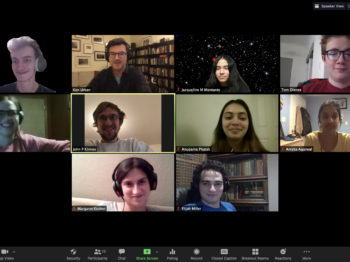
Listen to the music of a spider’s web. Tell me what do you hear?
It is an eerie, foreboding, reverberating tune, enough to send a tingle down your spine.
EDITORIAL DIRECTOR
Leah Talatinian
Senior Officer for Marketing and Communications

It is an eerie, foreboding, reverberating tune, enough to send a tingle down your spine.

Spiders rely on the vibrations in their webs to perceive their environment, and now we can hear their mysterious music.

The inflatable pillars invite visitors to breathe along with its pulsing lights.

Spiders don’t have great eyesight.

The artist Ekene Ijeoma has been working on “A Counting,” an art project involving numbers and language, for more than a year. Now, a sign language edition has begun.

Artist Ekene Ijeoma finds the humanity in data points.

An Interview With Ken Urban By Hayley Finn
Chi-Yua Yu and Markus J. Buehler from MIT created a computer program that transforms viral proteins into music!

Going online expanded the Lab’s access to theater professionals, giving students and recent alumni a chance to learn new skills, refine their plays — and work with high-caliber actors and directors When Covid-19 forced the MIT campus to shut down … Continued

Watch the MTA Playwrights Lab—a collaboration between MIT students and professional theater artists—stage performance readings featuring the work of student writers.

MIT Music and Theater Arts announce 3rd annual Playwrights Lab

The Coronavirus emergency left the landscape for the arts gloomy, but Guerilla Opera’s thirteenth season had successes which propelled the company into a new era of female leadership and artistry.

A new video re-creates a history that never happened, showing the power of AI-generated media

Three artists on the future of the gallery system after Covid-19.

The Wilma, seeking to reopen in Philadelphia, says it will erect a new seating structure in which every party is in its own separate box.

Translating the genetic code of virus proteins into music helps reveal their intricacies; sounds ‘a little like Zappa’

Each person sings one note, explains the professor behind the idea, Eran Egozy

With help from Opera of the Future group at the Massachusetts Institute of Technology Media Lab, composer Tod Machover took samplings of cityscapes, vocalizations and texts from Philadelphians.

Years ago, Markus Buehler developed a method to model proteins through music.

Our shared economy depends most on what happens in between.

From tinkling harmonies as the virus disarms cells to clashing and stormy as it replicates, U.S. scientists have translated the novel coronavirus’ spiked protein structure to music in an effort to better understand the pathogen.

The Opening Response titles a special series of interviews with artists, curators, writers, composers, mediators, and space-makers around the world.

Coronaviruses get their name from the crown of spikelike proteins that surround them. Now, the protein spikes of the novel coronavirus have been turned into an intriguing musical composition — one researchers hope could inspire new ways to fight the … Continued

You’ve probably seen dozens of images of the novel coronavirus—now responsible for 1 million infections and tens of thousands of deaths. Now, scientists have come up with a way for you to hear it: by translating the structure of its … Continued

Last year, MIT researchers announced that they were turning the biochemical properties of proteins into music. Now, they’ve used those musical compositions to create entirely new proteins.